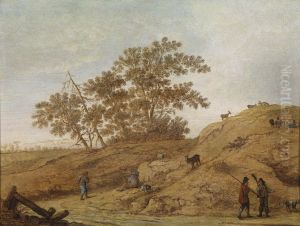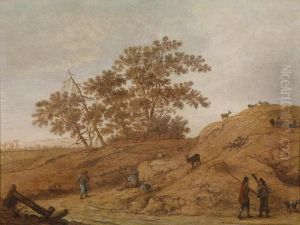Jan Hermansz Vinck Paintings
Jan Hermansz Vinck, a somewhat elusive figure in the annals of art history, was a Dutch painter who lived during the late 16th and early 17th centuries. Born in 1588, Vinck's life and career unfolded during a period marked by significant social, political, and artistic transformations. This era, often referred to as the Dutch Golden Age, saw the Netherlands emerge as a cultural and economic powerhouse, with art playing a pivotal role in its societal fabric. Despite the scarcity of detailed records about his personal life and training, Vinck is acknowledged as part of this vibrant artistic milieu, contributing his own unique voice to its legacy.
Vinck's artistic output, while not extensively documented, suggests he was influenced by the prevailing trends of his time, including Caravaggism and the early Baroque style. These movements, characterized by their dramatic use of light and shadow, as well as a focus on realism and emotional intensity, were sweeping across Europe and had found a receptive audience in the Dutch Republic. Artists of the period were increasingly interested in depicting everyday life, religious themes, landscapes, and still lifes, with an emphasis on direct observation and naturalistic representation.
Though specific works by Vinck are difficult to pinpoint with certainty, his style is thought to have resonated with the qualities of his contemporaries, blending the local Dutch aesthetic with broader European influences. The lack of comprehensive records on his oeuvre has made it challenging for art historians to fully assess his impact and situate him precisely within the broader landscape of Dutch art. However, references to his work in historical documents suggest that he enjoyed a degree of recognition and patronage during his lifetime.
Jan Hermansz Vinck's career was relatively short-lived, as he died in 1621 at the age of 33. Despite his premature death, his contributions to the Dutch Golden Age, though not as widely recognized as those of his peers, remain a part of the rich tapestry of 17th-century Dutch art. Today, scholars continue to piece together the puzzle of his life and work, aiming to better understand his place within one of the most celebrated epochs in art history. As research progresses, it is hoped that more light will be shed on Vinck and his artistic legacy, offering a fuller picture of his contributions to the Dutch Golden Age.

